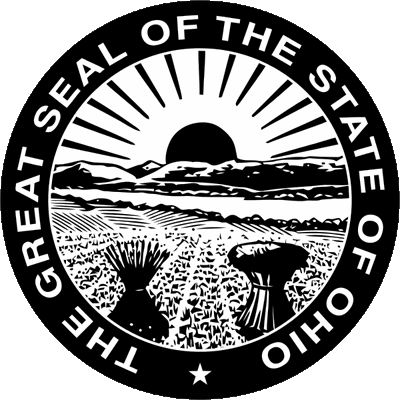- » 50 States
- » Histories
- » State Symbols
- » Seals
Ohio State Seal
Great Seal of the State of Ohio

Adopted in 1967.
The current design of the Great Seal of the State of Ohio was officially adopted in 1967 and modified in 1996.
The Great Seal of the State of Ohio features the U.S. state's coat of arms surrounded by the words, "THE GREAT SEAL OF THE STATE OF OHIO" in news gothic capitals (ORC §5.10). Ohio's coat of arms features a full sheaf of wheat, symbolizing agriculture and bounty; a cluster of seventeen arrows, symbolizing Ohio's admittance as the seventeenth of the United States of America; a representation of Mount Logan, Ross County, as viewed from the Adena Mansion; a rising sun three-quarters exposed and radiating thirteen rays to represent the original thirteen states shining over the first state of the Northwest Territory; and a representation of the Scioto River and cultivated fields (ORC §5.04).
Ohio Great Seal
History Ohio Coat of Arms

Adopted on March 28, 1803;
Current 1996.
The seal's design has changed at least ten times in the state's history. The original coat of arms, based on a sketch by Secretary of State William Creighton, Jr., was adopted on March 28, 1803, for official use by the governor. However, the original legislation was repealed in 1805, leading to a wide array of designs. For example, the 1847 seal depicted in the Statehouse rotunda skylight includes a canal boat. On April 6, 1866, a Republican General Assembly adopted an elaborate coat of arms that stipulated:
...supporting the shield, on the right, shall be the figure of a farmer, with implements of agriculture and sheafs of wheat standing erect and recumbent; and in the distance, a locomotive and train of cars; supporting the shield, on the left, shall be the figure of a smith, with anvil and hammer; and in the distance, water, with a steamboat; at the bottom of the shield there shall be a motto, in these words: Imperium in Imperio.
- Ohio General Code §1
The Republicans' new motto proved unpopular, as it ironically recalled states' rights just after the Civil War. A Democratic General Assembly replaced
the entire coat of arms with a much simpler design on May 9, 1868.
The Ohio General Assembly adopted the current coat of arms in 1967. The latest modification, in 1996, reduced the
number of rays from 18 to 13. There were unsuccessful attempts in 1999, 2003, and 2011 to add the Wright Flyer to the seal.
From 2004 to 2010, the state's official coat of arms served as a backdrop for the Bureau of Motor Vehicles' "Sunburst" license plate design, which was issued over a longer period than any other design since the 1980s.
Symbols
In the foreground, a sheaf of wheat represents Ohio's agricultural strength. A bundle of 17 arrows symbolizes Ohio's status as the 17th state admitted to the union. Thirteen rays around the sun represent the thirteen original colonies shining over the first state in the Northwest Territory. The background contains a portrayal of Mount Logan, with a three-quarter full sun rising behind it--symbolizing that Ohio was the first state west of the Allegheny Mountains. The Scioto River flows between the mountain and the cultivated fields in the foreground. Here is the section of the Ohio Revised Code describing the state seal.
Ohio Revised Code
GENERAL PROVISIONS
Chapter 5: STATE INSIGNIA; SEALS; HOLIDAYS
5.04 State coat of arms.
The coat of arms of the state shall consist of the following device: a circular shield; in the right foreground of the shield a full sheaf of wheat
bound and standing erect; in the left foreground, a cluster of seventeen arrows bound in the center and resembling in form the sheaf of wheat; in the
background, a representation of Mount Logan, Ross county, as viewed from Adena state memorial; over the mount, a rising sun three-quarters exposed
and radiating thirteen rays to represent the thirteen original colonies shining over the first state in the northwest territory, the exterior extremities
of which rays form a semicircle; and uniting the background and foreground, a representation of the Scioto river and cultivated fields.
The coat of arms of the state shall correspond substantially with the following design:
When the coat of arms of the state is reproduced in color, the colors used shall be substantially the same as the natural color of the terrain and
objects shown.








